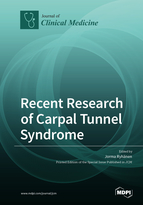Recent Research of Carpal Tunnel Syndrome
A special issue of Journal of Clinical Medicine (ISSN 2077-0383). This special issue belongs to the section "Orthopedics".
Deadline for manuscript submissions: closed (31 May 2022) | Viewed by 53114
Special Issue Editor
Special Issue Information
Dear Colleagues,
Carpal tunnel syndrome (CTS) is a very common compression neuropathy in the general population. In addition to unpleasant symptoms, the disease significantly causes sick leave, incapacity for work, and doctor visits. Conservative treatment helps with mild and transient symptoms, but often this syndrome requires surgical treatment. Surgical decompression of the median nerve is one of the most common surgical operations. If the symptom persists for a long time and treatment is delayed, this can result in a lack of sensation in the median area in addition to thenar atrophy and weakness of the thumb opposition. This can lead to disability, and for example, older people have difficulty coping alone at home. Research into carpal tunnel syndrome is active, and we are gaining a better understanding of the etiology and implications of this interesting disease. There are many impressive things behind CTS that we do not know yet; anatomical causes, links to other diseases and medication, occupational exposures and predisposing lifestyle risk factors. Is genetics providing any new information about the underlying factors and pathology of carpal tunnel syndrome? Diagnostics and differential diagnostics of CTS have their own challenges, and new methods such as ultrasound and handheld devices can challenge traditional electrodiagnostic methods. Conservative treatment practices of CTS are diverse and unambiguous best practice is not clear. Clinical symptoms, electromyography (EMG) finding, and possible differential diagnostic challenges should be considered when deciding on surgery. Surgical treatment varies somewhat from hospital to hospital and from country to country. In some hospitals, surgical decompression of median nerve is a short mini-invasive endoscopic wide-awake procedure, while in others, surgery is still an open procedure under general anesthesia or axillary block. When the CTS diagnosis and treatment is done too late for nerves to recover or there is perioperative complication, some late reconstructive surgeries might be needed. These nerve surgery techniques can be done by experienced hand surgeons. The quality of care, complications, and cost effectiveness of different methods require further research. This Special Issue will present the latest research on this interesting and clinically significant syndrome from the best researchers in the field. The focus is to present a broad range of high-quality articles in carpal tunnel syndrome research.
Dr. Jorma Ryhänen
Guest Editor
Manuscript Submission Information
Manuscripts should be submitted online at www.mdpi.com by registering and logging in to this website. Once you are registered, click here to go to the submission form. Manuscripts can be submitted until the deadline. All submissions that pass pre-check are peer-reviewed. Accepted papers will be published continuously in the journal (as soon as accepted) and will be listed together on the special issue website. Research articles, review articles as well as short communications are invited. For planned papers, a title and short abstract (about 100 words) can be sent to the Editorial Office for announcement on this website.
Submitted manuscripts should not have been published previously, nor be under consideration for publication elsewhere (except conference proceedings papers). All manuscripts are thoroughly refereed through a single-blind peer-review process. A guide for authors and other relevant information for submission of manuscripts is available on the Instructions for Authors page. Journal of Clinical Medicine is an international peer-reviewed open access semimonthly journal published by MDPI.
Please visit the Instructions for Authors page before submitting a manuscript. The Article Processing Charge (APC) for publication in this open access journal is 2600 CHF (Swiss Francs). Submitted papers should be well formatted and use good English. Authors may use MDPI's English editing service prior to publication or during author revisions.
Keywords
- carpal tunnel syndrome
- entrapment neuropathy
- carpal tunnel syndrome* / epidemiology
- carpal tunnel syndrome* / diagnosis
- carpal tunnel syndrome* / therapy
- carpal tunnel syndrome* / surgery
- carpal tunnel syndrome* / risk factors







